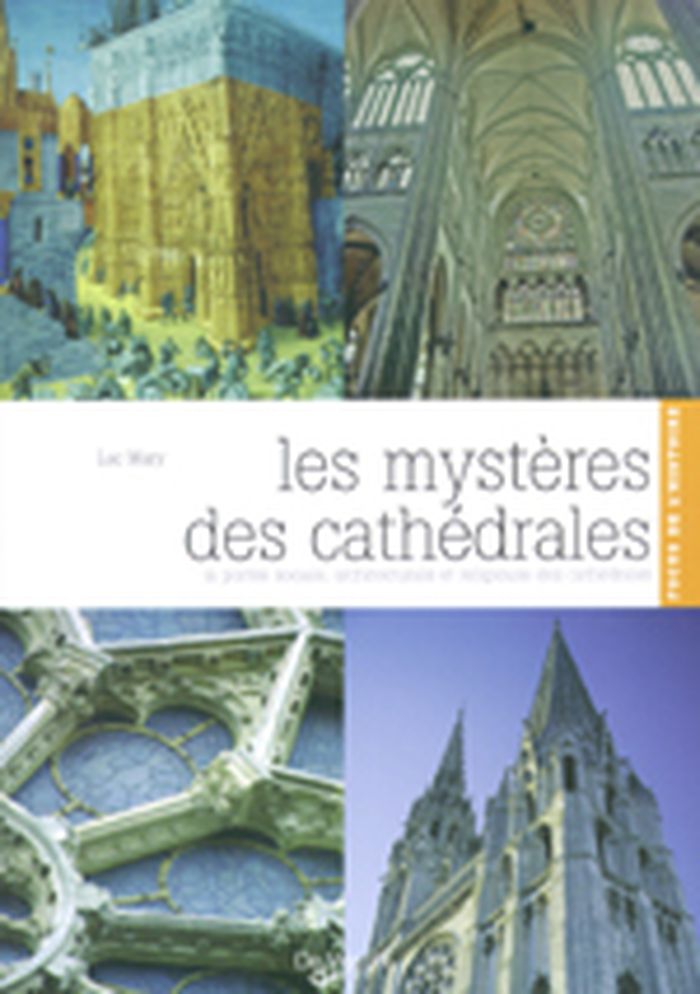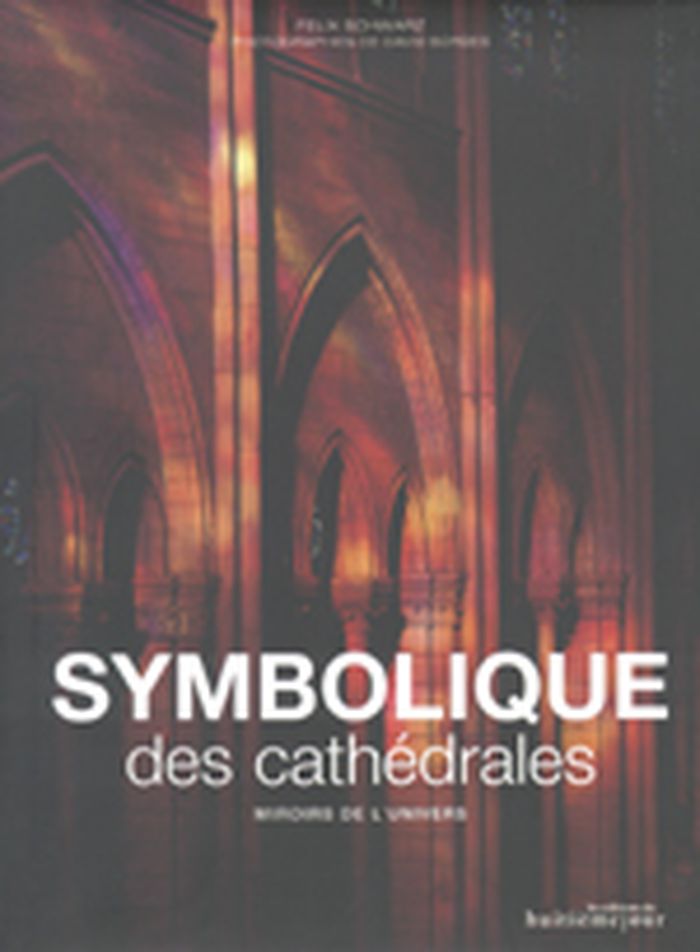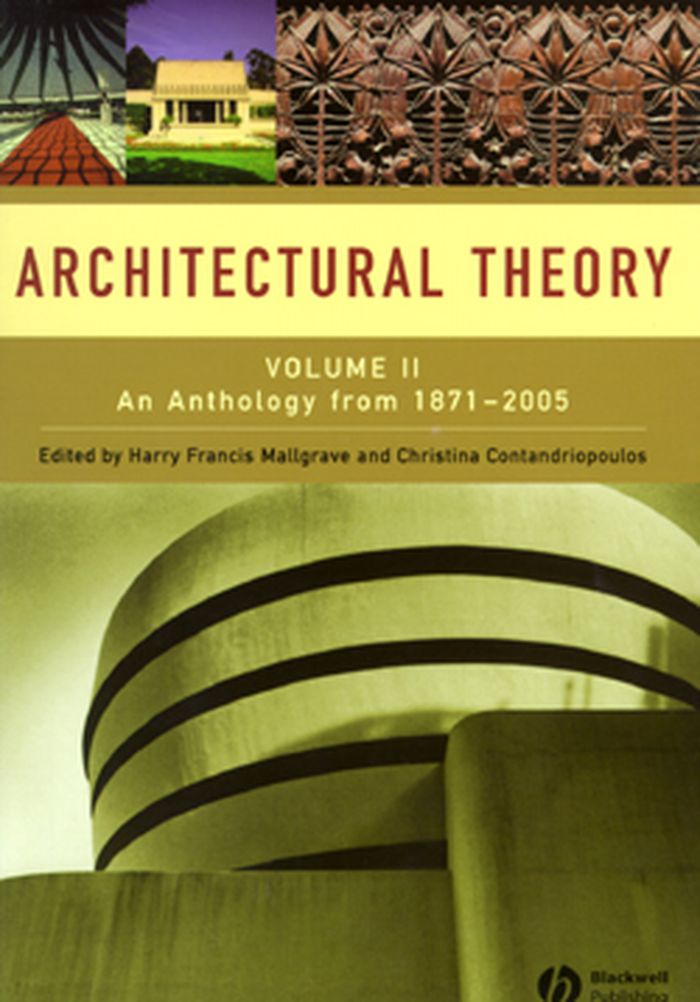Les mystères des cathédrales : la portée sociale, archtiecturale et religieuse des cathédrales
$22.95
(disponible sur commande)
Résumé:
Chartres, Beauvais, Amiens, Reims... Toutes ces villes doivent une grande partie de leur rayonnement culturel à leur cathédrale. Défi à la fois technique, humain et financier, l'aventure de ces véritables Tours de la Foi, narrée dans ces pages par Luc Mary, rend compte de l'étonnante croissance économique qui a caractérisé la France à partir du XIIe siècles. La collection(...)
Les mystères des cathédrales : la portée sociale, archtiecturale et religieuse des cathédrales
Actions:
Prix:
$22.95
(disponible sur commande)
Résumé:
Chartres, Beauvais, Amiens, Reims... Toutes ces villes doivent une grande partie de leur rayonnement culturel à leur cathédrale. Défi à la fois technique, humain et financier, l'aventure de ces véritables Tours de la Foi, narrée dans ces pages par Luc Mary, rend compte de l'étonnante croissance économique qui a caractérisé la France à partir du XIIe siècles. La collection «Focus de l'histoire» propose de petits guides construits autour de grands thèmes ou de grands moments du passé. Sous forme de fiches illustrées, ils permettent de découvrir ou de se remémorer les événements essentiels, les dates à retenir, les grandes figures, les épisodes marquants.
Histoire jusqu’à 1900
Symbolique des cathedrales
$37.50
(disponible sur commande)
Résumé:
La collection " Symbolique " aborde les sites et monuments de France sous un jour nouveau. Elle les révèle dans leur essence profonde, dans ce qu'ils ont de permanent et d'essentiel, par le langage universel du symbole, un langage accessible à tous. Véritables montagnes sacrées au cœur des cités médiévales, les cathédrales sont une image réduite de la création : on y(...)
Symbolique des cathedrales
Actions:
Prix:
$37.50
(disponible sur commande)
Résumé:
La collection " Symbolique " aborde les sites et monuments de France sous un jour nouveau. Elle les révèle dans leur essence profonde, dans ce qu'ils ont de permanent et d'essentiel, par le langage universel du symbole, un langage accessible à tous. Véritables montagnes sacrées au cœur des cités médiévales, les cathédrales sont une image réduite de la création : on y retrouve les trois plans de l'Univers, le Ciel, la Terre et le Monde Souterrain (le chœur, le transept et la nef). Et les lois qui ont présidé à sa construction sont celles-là mêmes qui ont permis à l'Univers de se manifester. Une partie de ce livre est consacrée à l'étude des lois fondamentales de l'architecture sacrée : le Nombre, la Géométrie et l'Architecture dont l'auteur nous rappelle que ce sont ces trois sciences divines qui ordonnent les cathédrales, comme l'Univers entier.
Histoire jusqu’à 1900
$74.95
(disponible sur commande)
Résumé:
This second volume of the landmark Architectural Theory anthology surveys the development of architectural theory from the Franco-Prussian war of 1871 until the end of the twentieth century. The entire two volume anthology follows the full range of architectural literature from classical times to present transformations.
Histoire jusqu’à 1900
août 2008, Malden
Architectural theory Vol. 2: an anthology from 1871 to 2005
Actions:
Prix:
$74.95
(disponible sur commande)
Résumé:
This second volume of the landmark Architectural Theory anthology surveys the development of architectural theory from the Franco-Prussian war of 1871 until the end of the twentieth century. The entire two volume anthology follows the full range of architectural literature from classical times to present transformations.
Histoire jusqu’à 1900
livres
$74.95
(disponible sur commande)
Résumé:
Si la France est le pays le plus visité au monde, ce n'est pas un hasard : son histoire mouvementée est inscrite dans la pierre. Le parti pris original de ce livre est, en effet, de raconter l'histoire de notre pays à travers ses vestiges (sites ou objets). Tout autant que la découverte du patrimoine français, c'est une autre façon d'écrire l'histoire qui se décline ici.(...)
100 monuments pour raconter l'histoire de France
Actions:
Prix:
$74.95
(disponible sur commande)
Résumé:
Si la France est le pays le plus visité au monde, ce n'est pas un hasard : son histoire mouvementée est inscrite dans la pierre. Le parti pris original de ce livre est, en effet, de raconter l'histoire de notre pays à travers ses vestiges (sites ou objets). Tout autant que la découverte du patrimoine français, c'est une autre façon d'écrire l'histoire qui se décline ici. Les auteurs nous invitent à découvrir les premières traces d'écriture dans les grottes de Lascaux, à rejoindre Diderot au Procope, rédigeant son encyclopédie ou à suivre les Bleus dans les couloirs du Stade de France par une belle soirée de juillet, grâce à un texte bien documenté et une iconographie ancienne et moderne très riche. De la Préhistoire à la période contemporaine, c'est toute l'histoire de France qui est revisitée
livres
mai 2007, Genève
Histoire jusqu’à 1900
livres
$74.95
(disponible sur commande)
Résumé:
La France des villages est d'une diversité inouïe. Montagnards, maritimes ou de plaine, constitués d'une rue unique ou de véritables labyrinthes, agencés en cercle ou suivant les courbes d'un cours d'eau, à flanc de coteau ou noyés dans les vignes, d'ardoise, de grès ou de bois, les villages charment par leurs singularités et leur caractère souvent insolite. Portant(...)
Merveilleux villages de France
Actions:
Prix:
$74.95
(disponible sur commande)
Résumé:
La France des villages est d'une diversité inouïe. Montagnards, maritimes ou de plaine, constitués d'une rue unique ou de véritables labyrinthes, agencés en cercle ou suivant les courbes d'un cours d'eau, à flanc de coteau ou noyés dans les vignes, d'ardoise, de grès ou de bois, les villages charment par leurs singularités et leur caractère souvent insolite. Portant l'empreinte de l'histoire, ils constituent un patrimoine unique et précieux. Aude de Tocqueville, spécialiste du patrimoine régional français, nous offre un choix de 135 villages répartis entre sept grandes familles (Sentinelles, Au bord de l'eau, Au cœur des vignes, Ames montagnardes, Où souffle l'esprit, Villégiatures, Pays d'artisans). A travers un panorama passionnant, cet ouvrage révèle les joyaux patrimoniaux de certains des plus beaux villages de France, sans oublier les richesses souvent méconnues des villages restés en marge des routes touristiques.
livres
janvier 1900, Genève
Histoire jusqu’à 1900
livres
Vauban, génie maritime
$51.00
(disponible sur commande)
Résumé:
Vauban, le protecteur de toutes nos frontières terrestres, aura marqué de son empreinte le siècle de Louis XIV. Mais le commissaire général des Fortifications se passionnera aussi pour la mer et la défense des côtes et des îles. De cap en cap, «côté terre comme côté mer», rien n'échappe à l'homme de guerre devenu homme de mer. Il «rôdait la côte», «y trouvait des trésors(...)
janvier 2007, Paris
Vauban, génie maritime
Actions:
Prix:
$51.00
(disponible sur commande)
Résumé:
Vauban, le protecteur de toutes nos frontières terrestres, aura marqué de son empreinte le siècle de Louis XIV. Mais le commissaire général des Fortifications se passionnera aussi pour la mer et la défense des côtes et des îles. De cap en cap, «côté terre comme côté mer», rien n'échappe à l'homme de guerre devenu homme de mer. Il «rôdait la côte», «y trouvait des trésors cachés», pour y édifier ici une citadelle et une ville nouvelle, là un port et son arsenal, ailleurs un fort à la mer. Sur plus de 3 000 kilomètres de côtes, de Dunkerque à Antibes, s'élèvent d'imposantes constructions, preuves du génie de Vauban. Arnaud d'Aunay nous entraîne avec son œil d'artiste sur les traces de son aïeul, l'infatigable gentilhomme du Morvan.
livres
janvier 2007, Paris
livres
Byzance
$30.95
(disponible sur commande)
Résumé:
Continuateur de l'Empire romain depuis la fondation de Constantinople en 330 jusqu'à sa chute en 1453, l'Empire byzantin dut la première puissance de la chrétienté dont la religion orthodoxe est l'héritière directe. Etabli en Asie comme en Europe, il a tissé un lien fort entre ces deux continents. Son héritage artistique fabuleux et son rôle décisif dans la transmission(...)
Byzance
Actions:
Prix:
$30.95
(disponible sur commande)
Résumé:
Continuateur de l'Empire romain depuis la fondation de Constantinople en 330 jusqu'à sa chute en 1453, l'Empire byzantin dut la première puissance de la chrétienté dont la religion orthodoxe est l'héritière directe. Etabli en Asie comme en Europe, il a tissé un lien fort entre ces deux continents. Son héritage artistique fabuleux et son rôle décisif dans la transmission des textes de l'Antiquité grecques ont assuré la gloire d'une civilisation qui a su enrichir son respect des traditions d'une fascinante audace créatrice.
livres
octobre 2006, Paris
Histoire jusqu’à 1900
livres
$27.95
(disponible sur commande)
Résumé:
Chaque automne à l'époque de la chasse, Louis XVI, la reine et la cour séjournaient à Fontainebleau. C'est dans le cadre de ces séjours que Marie-Antoinette fait aménager son boudoir en 1786. Conçu par Pierre Rousseau, il se distingue par la préciosité de ses décors, ses motifs naturalistes et floraux, son harmonie chromatique et ornementale. Récemment rendues à leur(...)
Le Boudoir de Marie-Antoinette à Fontainebleau
Actions:
Prix:
$27.95
(disponible sur commande)
Résumé:
Chaque automne à l'époque de la chasse, Louis XVI, la reine et la cour séjournaient à Fontainebleau. C'est dans le cadre de ces séjours que Marie-Antoinette fait aménager son boudoir en 1786. Conçu par Pierre Rousseau, il se distingue par la préciosité de ses décors, ses motifs naturalistes et floraux, son harmonie chromatique et ornementale. Récemment rendues à leur beauté originelle au terme d'une exceptionnelle campagne de restauration qui a mobilisé une équipe d'artisans pendant de longs mois, deux meubles remarquables retiennent l'attention : une table en auge et un bureau à cylindre parés de nacre signés par le grand ébéniste Jean-Henri Riesener.
livres
novembre 2006, Paris
Histoire jusqu’à 1900
livres
$34.95
(disponible sur commande)
Résumé:
Une cité aux origines grecques Une ville majeure de l'Empire romain Un rayonnement sur la Gaule méridionale fondé sur le commerce maritime Recherches et découvertes archéologiques La parure monumentale de Marseille
Histoire jusqu’à 1900
janvier 2007, Paris
Marseille antique : guides archéologiques de la France
Actions:
Prix:
$34.95
(disponible sur commande)
Résumé:
Une cité aux origines grecques Une ville majeure de l'Empire romain Un rayonnement sur la Gaule méridionale fondé sur le commerce maritime Recherches et découvertes archéologiques La parure monumentale de Marseille
livres
janvier 2007, Paris
Histoire jusqu’à 1900
$14.50
(disponible sur commande)
Résumé:
Suite au raid effectué en 1692 par Victor-Amédée de Savoie dans le Haut-Dauphiné, Vauban propose à Louis XIV d'améliorer la défense de la frontière des Alpes par une nouvelle place forte. Elle est nommée Mont-Dauphin en l'honneur du fils du roi, le Grand Dauphin. Dissuasive avant tout, elle prouve son efficacité et ne reçoit le baptème du feu qu'au hasard d'une bombe(...)
Mont-Dauphin : Place forte de Vauban
Actions:
Prix:
$14.50
(disponible sur commande)
Résumé:
Suite au raid effectué en 1692 par Victor-Amédée de Savoie dans le Haut-Dauphiné, Vauban propose à Louis XIV d'améliorer la défense de la frontière des Alpes par une nouvelle place forte. Elle est nommée Mont-Dauphin en l'honneur du fils du roi, le Grand Dauphin. Dissuasive avant tout, elle prouve son efficacité et ne reçoit le baptème du feu qu'au hasard d'une bombe italienne lâchée en 1940. Sa visite la montre donc telle qu'elle a été conçue, avec ses bastions, ses bâtiments militaires mais aussi ses demeures civiles du XVIIe siècle qui témoignent des efforts de Vauban pour créer une ville dans ce cadre austère de haute montagne. Construit sur un promontoire rocheux aux abrupts grandioses, Mont-Dauphin est en effet situé entre le Parc national des Ecrins et le Parc régional du Queyras, parcs naturels prestigieux dans la découverte desquels il peut s'inscrire.
Histoire jusqu’à 1900



